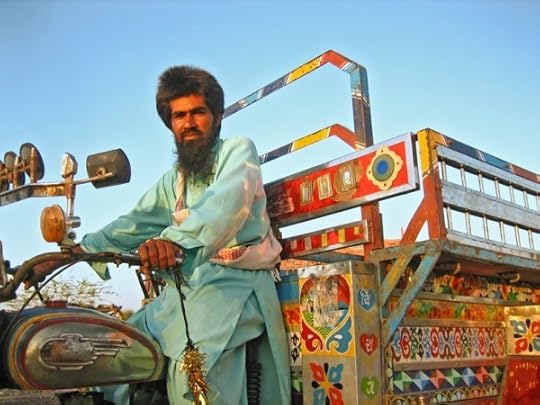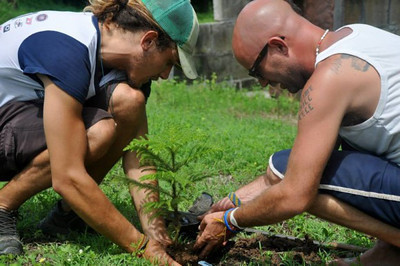Matador Network's Blog, page 2315
February 18, 2014
35 stunning photos of Costa Rica
COSTA RICA has staked its reputation on being a progressive pioneer when it comes to environmental conservation policy. A full 25% of its territory falls under national park status or some other designation of protection. Deforestation — a serious concern in a state that’s 50% forest — has been halted almost entirely. The legislature banned recreational hunting in 2012, and the government is aiming to become the world’s first carbon-neutral nation by 2021.
And Costa Ricans have plenty to protect. Their tiny country (around the size of two Vermonts) accounts for just 0.1% of the world’s land area, but is home to almost 5% of its biodiversity. From rare amphibians to monkeys to big cats to sea turtles and over 800 different bird species, Costa Rica’s fauna is as impressive as its volcanic, rainforest-covered landscape.
For the traveler, all of this adds up to pretty much the most spectacular ecotourism opportunities anywhere, as well as plenty of volunteer-based travel options. Below are some snapshots of what you can expect when you go.
This post is sponsored by Contiki, the world leaders in youth travel. Share where you feel closest to nature for a chance to win one of three spots on a Costa Rica Unplugged adventure. Enter the Storytellers: Costa Rica contest.

1
Storm at Playa Avellanas, Nicoya
Located on the thick arm of the Nicoya Peninsula, Avellanas lies about 10km south of Tamarindo and offers mellower waves than the more popular Playa Negra farther south.
Photo: Roman Königshofer

2
Volcán Arenal
Though nowhere near the tallest volcano in Costa Rica, Arenal is the most active, regularly putting on shows like this. It gives its name to the national park that surrounds it.
Photo: Scott Robinson

3
Sunrise on the beach
Costa Rica has over 750 miles of coastline on both the Pacific and Caribbean, which means a whole lot of beach.
Photo: Frontierofficial

See more: 35 surprising facts about sharks that might change your opinion of them

4
Green sea turtle
The green sea turtle (this one was photographed in Hawaii) is one of many endangered species that depends on Costa Rica for its survival. The Tortuguero Conservation Area is the single most important nesting site for the Atlantic subpopulation of green turtles, and serves as an epicenter for turtle conservation.
Photo: Roy Niswanger

5
Cruising the zipline
Many of the country's ecotourism zones feature ziplines, which sling visitors over rainforests and waterfalls. The highest concentration is in the La Fortuna/Arenal area.
Photo: Alex

6
Hammerhead at Cocos Island
Cocos sits 340 miles southwest of mainland Costa Rica (about halfway to the Galapagos) and is an uninhabited national park. If you manage to make it out here, you've probably done so for the diving—some of the best in the world.
Photo: Barry Peters

7
Arenal in cloud
The volcano's 5,350ft peak is often banked in clouds—which doesn't really detract from the view.
Photo: Scott Robinson

8
Green and black poison dart frog
One of Costa Rica's 133 species of frog, this specimen was photographed in the rainforests of the Gandoca-Manzanillo Wildlife Refuge, near the border with Panama.
Photo: Geoff Gallice

9
Llanos de Cortez Waterfall, Guanacaste
A quick detour off the Panamerican Highway in Guanacaste Province will take you to this waterfall and swimming hole, which has its own white-sand beach.
Photo: "Mike" Michael L. Baird, flickr.bairdphotos.com
Intermission

40 images of Peru we can’t stop looking at

50 images of New Zealand we can’t stop looking at

Amazing animal intelligence

10
Mango break
One of the many tropical fruit options at markets in the capital San Jose and around the country.
Photo: Everjean

11
Baby two-toed sloth
These arboreal mammals are native to Costa Rica. According to the photographer, this little guy is under the care of the Jaguar Rescue Center in Puerto Viejo de Talamanca.
Photo: Matt MacGillivray

12
Rolling hills
The mountains of Costa Rica run down the center of the country and are flanked by rolling green hills and farmland like this.
Photo: Ray Che

13
Pacific sunset
A mellow sundowner on the Pacific coast near Nuevo Colon, Guanacaste.
Photo: Melissa Roy

14
Vibrant butterfly
A large chunk of Costa Rica's biodiversity is made up by its 300,000+ species of insects, which include 1,250 butterfly species—10% of the world's total.
Photo: Frontierofficial

15
Catarata del Toro
Just north of San Jose, this waterfall plunges from a hole in the cliff face 300 feet to the bottom of an extinct volcanic crater.
Photo: Steve Jurvetson
Intermission

Kayaking with crocodiles in Costa Rica [VID]

Travel guide: Surfing and fishing Tamarindo, Costa Rica

30 images of Morocco we can’t stop looking at

16
Sunset over Manuel Antonio
On the central Pacific coast near Quepos, this is the sunset view from Buena Vista Villas & Casas, in Manuel Antonio National Park.
Photo: kansasphoto

17
Costa Rican breakfast
The star of the plate here is gallo pinto, or "spotted rooster," a rice-and-beans concoction that's a national dish of Costa Rica (also claimed by Nicaragua).
Photo: The LEAF Project

18
No mistaking it—this is the tropics
This view of Arenal and the surrounding tropical forest drives home the Jurassic Park-level of lushness of Costa Rican flora.
Photo: Arturo Sotillo

19
Volcán Poás
A good 3,000 feet taller than Arenal is Volcán Poás, another active volcano in central Costa Rica. It has erupted 39 times since 1828 and has dual crater lakes near the summit.
Photo: Apetitu

20
White-headed capuchin
This is one of four species of monkey native to Costa Rica and probably the easiest to spot. It can make its home in pretty much any type of tropical forest.
Photo: Gloria Manna

21
Monteverde Cloud Forest Reserve
Near the town of the same name, in the Tilarán Mountains, this reserve protects a 26,000-acre tract of virgin rainforest consisting of six different eco zones and tremendous biodiversity.
Photo: Thomas Frost Jensen

22
Playa Herradura sunset
Another Pacific sunset, this one taken in Playa Herradura, one of the country's most popular tourist draws, located an hour west of San Jose.
Photo: Andrew Morrell

23
Hummingbird
Costa Rica is home to over 800 known species of birds. This hummingbird was photographed in Alajuela.
Photo: Jon Fife

24
Day's end
A vodka sundowner at a luxury resort in Manuel Antonio National Park, one of Costa Rica's smallest but also one of its most renowned, combining rainforest and beach landscapes.
Photo: sean hobson

25
Rio Agujitas at Drake Bay
The relatively short Agujitas River rises in the forested hills of the Osa Peninsula and empties into Drake Bay just north of Corcovado National Park.
Photo: Trish Hartmann

26
Monkey silhouettes
A pair of monkeys, mother and child, spotted at the luxury resort Hacienda Pinilla, on the Nicoya Peninsula.
Photo: Paul Kehrer

27
Irazú Volcano National Park
From the photographer: "This picture was taken during our road trip in Costa Rica, while visiting the Irazú Volcano National Park. From the top it is possible to see both the Atlantic and Pacific Oceans on a clear day. However, such clear days are very rare and it is typical for the volcano's summit to be covered in cloud for much of the time. Although we did not have the opportunity to observe the beautiful view from the top, these clouds created a very mysterious atmosphere and made the landscape very photogenic."
Photo: Céline Colin

28
Cocoa beans, raw ingredient of Costa Rican chocolate
Many small-scale chocolate producers operate in Costa Rica, offering tours of their working facilities.
Photo: Everjean

29
Laguna Verde, Volcán Irazú
Within one of the multiple craters at the summit of the volcano Irazú is this green lake, so colored on account of its chemical content.
Photo: Cristina Valencia

30
Surfing Costa Rica
People have been traveling to surf Costa Rica for decades—there are breaks to hit all along the Pacific coast, as well as a few on the Caribbean side.
Photo: Darren Johnson

31
Scarlet macaws
This distinctive parrot species can be seen in a few of Costa Rica's preserves. The pair shown above was photographed near Carara National Park.
Photo: Andrew Morrell

32
Arenal's halo
A close-up shot of clouds draping the peak of Arenal.
Photo: carol patterson

33
Rio Celeste Falls
One of the northernmost of Costa Rica's 26 national parks, Tenorio Volcano is home to the Rio Celeste and this waterfall.
Photo: Bruce Thomson

34
Rhinoceros beetle
Rhinoceros beetles can reach lengths of up to six inches and are found in multiple parks in Costa Rica. They are completely harmless—they can't bite or sting. They may, however, freak you out.
Photo: Lyn Gateley

35
View from Cerro Amigos
Cerro Amigos is the highest point (6,000ft) in the Monteverde reserve. On a clear day, you can see Arenal, the Pacific, and even across the border north to Nicaragua.
Photo: Dennis Tang
 This post is sponsored by Contiki, the world leaders in youth travel. Share where you feel closest to nature for a chance to win one of three spots on a Costa Rica Unplugged adventure. Enter the Storytellers: Costa Rica contest.
This post is sponsored by Contiki, the world leaders in youth travel. Share where you feel closest to nature for a chance to win one of three spots on a Costa Rica Unplugged adventure. Enter the Storytellers: Costa Rica contest. The post 35 images of Costa Rica we can’t stop looking at appeared first on Matador Network.

February 17, 2014
Love lessons you learn in the desert

Photo: Meanest Indian
I first met Ali in the small marketplace outside of the Jaisalmer Fort. Hawkers sat on mats behind their vegetables waiting for business, while dogs rested in the shadows. Yellow sandstone buildings surrounded the market. Dust kicked up by dawdling cows and passing scooters hung in the air and gave the scene a surreal golden glow. The morning heat promised a sultry afternoon and carried the scent of chai tea, samosas, and animals.
A wide-eyed, smiling Indian man walked up to me. “Hello, sir,” he said. “I am Ali.” He leapt into his story. Ali, like many others in Jaisalmer, could not read or write, and needed me to send his girlfriend a text message.
“Say something nice!” he pled.
“Well, what exactly do you want me to say?”
“That I love her and that I wish she was here, and that she is beautiful.”
“How about just saying you miss her?”
“Tell her I want to marry her!” he beamed.
“That’s not very subtle.”
“Tell her I love her!” he yelled.
I did just that, abandoning any coyness I may have had were it my own relationship. I showered his beloved with clichéd compliments. Ali loved it; it was exactly what he wanted to say. And so it began — from then on I was his go-to guy. Every day he would invite me to drink chai and plot the courtship of his girlfriend by barraging her with adoring messages.
I was in Jaisalmer to volunteer with one of the popular camel safaris and escape the frenzy of ordinary India. My job was to help the business with their email correspondence, although I was quickly put to use in different matters. It seemed Ali wasn’t the only one in town in need of a love-letter scribe. Soon enough I was playing the same role for every man in the camel safari company. I was continuously asked to write emails to foreign girls who had passed through Jaisalmer before, to write these almost strangers “the desert man love letters” that came from their desert man hearts.
I first found the camel drivers’ obsession and fascination with any girl that crossed their path alarming. They needed little encouragement or often none to become fixated with a girl, the actual reality of a possible romance having no bearing on their fantasies.
One plays matters of the heart safe under the excuse that one is living a greater adventure.
It was in stark contrast to my own approach. To keep the dream of extensive travel alive, I tend not to pursue relationships, to choose the freedom and loneliness of solo travel over the fulfillment and complications of love affairs. One plays matters of the heart safe under the excuse that one is living a greater adventure, the life of a wanderer.
It was on the desert safaris that I found the peace and open spaces I came looking for. Our group of tourists and guides would bounce along on the camels, squinting our eyes through the glare, searching for foxes or vultures or any form of life. Trotting along in single file and unable to chat, my thoughts, all our thoughts, would fade into a desert-induced reverie. Finally we would arrive at the campsite, relieved to give our aching bodies a respite from the constant pounding of the camel riding.
After lazily exploring the dunes, we would settle down to watch the sunset. It was under the spell of one of the sunsets that I remembered a quote about the ocean: that the wonderful thing about the ocean is that it makes you think the thoughts you like to think. It’s the same for the desert, I thought, or mountains, or any form of grand nature. So far removed from the tensions of peopled places, we could revel in the setting of the sun in silence or quiet conversation. It seemed like we were revitalizing our frayed souls with every deep breath and still moment.
This reflective air would continue into the night with the appearance of every new star. The guides would chat and gossip nonstop around their cooking fire, their teasing and laughing the melody to the constant beat of the slap-slap-slap of the chapati making. The guests’ campfire conversation was typically philosophical, often moving onto classic traveler discussions about how the world ought to be.
One such chat turned into a questioning of my own lifestyle. While the guides washed our dinner plates with the desert sand, I answered a volley of questions. Why was I still traveling? What was my motivation? I muttered something about everyone having their own path, that there are many different paths to happiness and this one happened to be mine. I tried to explain the sense one has that life is incomplete and that this cannot be all there is, the inner conviction that there must be something better, fuller, and more satisfying elsewhere.
But the guests wanted to know: What was it, what was I searching for? I wasn’t so sure I could say exactly what it was. I think I understand what the French philosopher Andre Breton meant when he said, “All my life, my heart has yearned for a thing I cannot name.” Fighting off sleep that night, I stared up at a panorama of stars so encompassing and bright it felt as if I were a star myself, floating freely amongst them. I lay thinking about that very question. What was I searching for?
The camel drivers knew exactly what they were searching for — and not finding. As time went on, their love letters remained unanswered and they grew despondent. Ali told me his girlfriend had realized it wasn’t him sending the romantic messages to her. She had stopped replying to them. He was distraught and feared it was the end.
I thought about how the drivers went wild with lust and adoration, and I felt slightly vindicated by not being so girl-crazy. On the other hand, what if I had it backwards? What if this extended traveling had in fact been a subconscious search for the bliss and fulfillment of love? What if what I was avoiding was the very thing I was searching for?
After a few weeks in the desert, I felt refreshed…even restless. It was time to move on. I drank one last chai with Ali, still as animated as when I first met him but with a certain fresh sorrow about him from his failed relationship. Something turned in me when I saw that, a type of jealousy. Not for his pain, but for his passion. And with that thought, I left. On a midnight train to Delhi my journey continued. As always, I was alone but free, still in search of that something more my heart cannot name. [image error]
The post These are the love lessons you learn in the desert appeared first on Matador Network.

How to snowboard the streets of NYC (like a boss)
THE FIRST SNOW in NYC is cute; the second one is annoying, but still charming. If it snows more than three times in one winter however, I’m ready to be anywhere else. It’s easy to hibernate in my apartment until it gets warmer, but leave it to filmmaker Casey Neistat to make even the dreariest of snow days especially epic.
Screw the mountains of Vermont – urban snowboarding is where it’s at! Just make sure you wear a helmet and, you know, avoid the cops. 
The post How to snowboard the streets of NYC (like a boss) appeared first on Matador Network.

7 ways to be a spontaneous explorer
“Life is a series of natural and spontaneous changes. Don’t resist them; that only creates sorrow. Let reality be reality. Let things flow naturally forward in whatever way they like.
- Lao Tzu
Greetings future explorer of the world! In this post we will be introducing you to Spontaneity and his mischievous cousin Serendipity. They have faithfully accompanied many great explorers throughout the ages, and we can guarantee that befriending these two on the road is bound to lead to unexpected wayward adventures and happy coincidences.
Inspired by guerrilla artist Keri Smith’s delightful book How To Be An Explorer of the World, and also some of the wonderfully creative ideas listed in the Lonely Planet Guide to Experimental Travel, we have compiled a short, illustrated field guide with seven ideas we hope will encourage you to succumb to your spontaneous urges, adopt a healthy caution against over-preparation, embrace serendipity, shed the heavy cloak of routine, chase down happenstance, and invite chance to be your chaperon.
1. Spin the globe.
The timeless ‘spin the globe’ technique is one of the best-known methods for inducing spontaneous travel and is wonderfully demonstrated by James McAvoy playing Dr. Nicholas Garrigan in the 2006 film The Last King of Scotland. Committing to travel to the first place your finger lands on takes a whole lot of ‘cojones,’ so for first timers we would recommend giving yourself three strikes — two practise spins if you will — before committing yourself to actually going to the country your finger lands on.
For added panache, we would suggest first pouring a glass of single malt whisky and spinning one of the rather fine hand-painted globes from the talented team at Bellerby & Co based in London, England.
2. Put your trust in a furry companion.
If you live in an urban area, either take your own dog or ask to borrow one from a friend. If, however, you’re living in Central Asia, perhaps you might consider commandeering a yak. In Western Africa? Try a camel. In the Australian bush? Jump on a kangaroo…you get the picture. Whichever your mammalian companion of choice, turn the tables and let it take you for a walk, you never know where you might end up!
3. Flip a coin and take a trip down memory lane.
This is one for the whole family, and perhaps your elderly neighbours too. Politely ask them to dig around for an old half-penny coin (or equivalent out-dated coin depending on your homeland), perhaps a vintage travel guide (such as one of these), and if you really want to commit yourself, a vintage bicycle or penny farthing from an antique store — complete with a set of retro trouser clips.
Once your intergenerational team has rounded itself up, set off down your local road at a moderate pace and at each junction take it in turns to flip your coin. Heads = go left. Tails = go right. Repeat this process for an afternoon, and along the way ask each other about memories from each place or junction — what did these places look like 10 or even 20 years ago? What has changed and what has remained the same? Enjoy the leisurely ride down memory lane.
4. Embark on a microadventure.
Surely you’ve heard of Al Humphrey’s microadventures by now? His premise is simple: You don’t need to fly to the other side of the planet to find wilderness and beauty — adventure is only a state of mind. Anyone can embark on a microadventure. Simply put the kettle on, pick up a map, and find somewhere rural you’ve never been to, despite it being close by.
After work, jump on a train or cycle there. Sleep under the stars on a hilltop, swim in a river, wake up in the sunshine. Return to your desk, a few twigs in your hair but happy to the core.
5. Seek points of confluence.
A point of confluence occurs at the integer-degree intersections where a line of latitude meets a line of longitude. There is a confluence within 49 miles (79km) of you if you’re on the surface of Earth, and there are 64,442 latitude and longitude degree intersections in the world (counting each pole as one intersection). Check out confluence.org to find out how many fall in your country.
These confluences are interesting because they represent the randomness that emerges from strict order. Seen another way, they are an open defiance of the order our culture imposes on us. As author Tim Vasquez says, “[Points of confluence are] curious places that embrace you in their history, character, and ecology, surrounded by people who are locals in every sense of the word.”
6. Up, up and away.
This idea was pioneered by the legendary Larry Walters, whose spontaneous misadventures inspired the Pixar classic UP. We do not advise that anyone actually attempt this at home, but Larry’s story is so spectacular we felt obliged to include it in this compendium. Larry was an American truck driver, who on July 2, 1982, took flight in a homemade airship named Inspiration I.
His beautiful “flying machine” consisted of an ordinary patio chair with 45 helium-filled weather balloons attached. It was reported that Inspiration I rose to an altitude of over 15,000 feet and floated from its takeoff spot in San Pedro, California, into controlled airspace near Los Angeles International Airport. Slightly safer alternatives to Larry’s method would include paragliding or attaching a GPS to a helium balloon and following it with your feet placed firmly on the ground.
7. Teach yourself to lucid dream.
Lucid dreaming is simply being conscious that you are dreaming. Tibetan Buddhists have practised dream yoga for centuries, and there’s a lot of literature behind the art and science of lucid dreaming — we found the simplest methods outlined in a post on the 4HWW blog. It requires a lot of practise to master lucid dreaming in the beginning, but once greater control has been developed, you can use your normal hours of REM sleep to visit anywhere in the world.
Quit your 9-5 job to fly over the Egyptian pyramids on the back of a giant eagle — check. Explore the depths of the ocean reefs without an oxygen tank — check. Base jump from Mt. Everest with Barack Obama — check. As with most things in life, the only limits are those imposed by your own imagination — have fun! [image error]
This post originally appeared over on the Maptia Blog; the team at Maptia have just launched their beautiful platform for telling stories about places.
The post 7 ways to become a spontaneous explorer of the world appeared first on Matador Network.

This man shouldn’t have survived his skydive. Watch how he did.
There might be a place that’s worse to be unconscious than thousands of feet up in mid-air while skydiving, but I’m really not sure where it is. Possibly sitting on a conveyor belt that’s moving towards a bandsaw? Regardless, the fact that unconsciousness is even a possibility is a pretty huge reason I never go skydiving (or sitting on bandsaw-tipped conveyor belts). 25-year-old British skydiver James Lee found this out the hard way, when he struck another diver, and was knocked unconscious thousands of feet up from the ground.
The entire thing was caught on his helmet cam.
Fortunately for him, two of the other skydivers noticed he had lost control, and upon realizing he was unresponsive, managed to reposition him and deploy his parachute. He then safely landed. The video has pretty much convinced me to never go skydiving, or possibly to only go skydiving with a couple of extremely competent, loyal, and ballsy friends. [image error]
[Feature photo: peasap]
The post This man shouldn’t have survived his skydive. Watch how he did. appeared first on Matador Network.

Argentina to Alaska in a Fiat 600

Driver and car taking a siesta in Playa Blanca, Costa Rica.
Photos courtesy of Juan Manuel Rizzatti and Santiago Uranga
Walking down 5th avenue in Playa del Carmen, Mexico, I spotted a small red Fiat 600 on one of the side streets. It had stickers all over it and looked small enough to put in your pocket.
Two tall guys stood outside of it, and I just had to go ask them what they were doing with such a tiny car. It turns out this small 1964 automobile is not just a car, but an instrumental part of a pretty damn cool travel project.
Juan Manuel Rizzatti and Santiago Uranga are the drivers and have brought the Fiat all the way from Argentina. They are only about halfway through their journey; their final destination is Alaska, and along the way they’ve been spreading seeds (quite literally) of change. Intrigued by the project, I peppered them with questions.

Alaska bound! Juan Manuel Rizzatti and Santiago Uranga started their journey in the ‘fitito’ from Rosario, Argentina on January 26, 2013.
TL: That’s a tiny car! How long can you drive before you NEED to stop and stretch your legs?
JMR + SU: Haha, it’s a good question. Usually we decide if we drive at night or during the day depending on the weather of the place. When it’s too hot, like it was in Chile’s and Peru’s deserts, we drive at night. We don’t stop so much at night because there are not many things to see or places to go, so we can drive maybe three hours without stopping. By that time the body starts to beg for a little walk.
When we drive with the sun over our heads, because of weather, or in some places also for security, (we try to avoid the roads during night in some regions), then it is the car who demands us to stop. His temperature rises in hot weather and if we add climbing a mountain, for example, we can stop every 20 minutes to let the engine breathe. Sometimes we also stop when we see a nice place to plant seeds.
I guess the most we’ve been without stopping was three hours. Maybe that’s why it took us one year to get from Argentina to Mexico!
But, despite the appearance, the little Fiat is not uncomfortable at all; what tires the driver the most are the hard ‘pedals’ and the attention you must keep on the road to not hit a pothole and ruin the car.

Giving ‘la Brasita’ a chance to catch its breath at Paso de Jama, Chile. Altitude, 4,200 meters.
Okay, now tell us about yourselves and this project. You have driven from Argentina to Playa del Carmen, Mexico, and are on your way to Alaska. Why are you doing this?
We do this because both of us love traveling, knowing places and people from different realities. Being ourselves in moments and situations where you feel freedom and a special perception of life and existence. We wanted to know the whole continent and spread a nice message on the road by leaving trees everywhere. In this case, because of the car, apart from the ecological message, I think we also carry an inspiring message, being an example that everything is possible if you focus, if you put your energy on that, if you do it with love and respect, giving thanks and having faith.
TL: What inspired you to take this project on?
The idea of doing this in the Fiat comes from a police friend of ours. This car is a classic in Argentina and still very popular. Santiago wanted to go to Uruguay to exhibit some of his photos in a gallery. He wanted to go in the ‘fitito’ (as we call them back home), despite everybody telling him he was crazy, that he would never make it with such a little old car to Uruguay (900km away; we’ve done around 25000km on this trip already by the way). So he called the police friend to ask him if the papers for the car were all in order to take it out of the country. A few days later he called saying, “The documents and everything are fine. With this car you can go to Alaska if you want!” So we thought: Why not??
We were also inspired by Masanobu Fukuoka, the Japanese permaculturist who used ‘seed bombs’ (called nendo dango in Japanese). He inspired us to plant trees all along the way. We wanted to do something related with the environment and ecology so these bombs were a great idea. After a few months, we started to plant seeds directly in the ground because of the weight of the clay used in the bombs. This project has been very nice to do, and as everything comes back, this help we are giving to the Earth comes back to us in love, friends, gifts, and many other ways of ‘help.’ This is our inspiration now to continue on this path.
TL: Can you tell us about the car? (Where did it come from, what kind of gas mileage does it get, etc.)
“Remember Santiago! Because I know you…This is an old car, don’t go around everywhere with it. It’s too old and small. It is just to use on Sundays.” This is what the previous owner said when he sold it. We say the Fiat has had maaaaaany Sundays!
How we came to have the Fiat: Santiago needed a car to go out just for one night, so he called a friend to see if he could borrow one of the cars on sale — just for the night. Between many other beautiful classics, this Fiat 1964 was chosen. When he took it back the next day, he couldn’t part with it and he became its new owner!
It’s a red Fiat 600 made in Argentina in 1964. It is the last model with the suicidal doors that open from the front. It keeps its originality, and the engine is a 755cc, which makes it very cheap for fuel. We can do about 20km with one liter.
We call him “Brasita de Fuego” after a little red bird we have in South America and always say: “The car is little but the heart is big.”
TL: Have you had any breakdowns or malfunctions with the car that have affected your schedule or route?

Just crossed in to Mexico.
Ufffff…We have had to stop many, many times because of the car. At the beginning, we had no idea of how to fix it — not at all. We depended completely on other drivers to help us. With time, experience, and after asking thousands of questions to dozens of mechanics, we learned how to do the basics, and some other necessary things that came up. Every time we have had any issue with the car, something good, positive, nice, or interesting happened because of that. As we don’t have a schedule or pre-established route maps, we say it is the car who decides the road and our destiny. We thank him.
It is important to say that the parts are almost impossible to get outside of Argentina or Italy, and we are here thanks to Leiva Autopartes. They sponsor us with all the necessary things for such a trip!!
TL: What countries have you been to and when did the trip begin? How many miles (or kms) have you driven so far?
We started on the 26th of January, 2013, from Rosario, Santa Fe, Argentina, with some TV cameras, family, friends, and people that read about the trip in the newspapers. We’ve been through Argentina, Chile, Peru, Ecuador, Colombia, sent the car in a container to Panama (we went in a sailboat), then Costa Rica, Nicaragua, Honduras, Guatemala, and now Mexico. We have made almost 25,000km, and I say almost because the ‘counter’ of the car doesn’t work and we calculate with the GPS and other travelers’ calculations. But that would be the approximate number and I think it is around half of the way to Alaska.
TL: What have people’s reactions to the project been like?
It has always been unbelievable, and the further we are from the start, the more people help. The first reaction is when they see the car, because of its beauty. The second reaction comes when they see the flags because of the adventurous spirit, and the third reaction is when they meet us, because of the craziness! Haha.
Seriously though, people have helped us a lot and it is because of that, that we can do this. Every encounter has been very positive. Everybody is immediately intrigued by the car. Car clubs have helped us a lot. Collectors, classic cars lovers, and people who feel this passion for cars — I think they can imagine better than most what it means to travel in such a car, and they always help us. They open up their doors for us and want us to take away a nice memory of their club, and their country.

Planting seedlings along the way.
As you know, to buy fuel, to pay road taxes, and to get some food — we exchange stickers for any volunteer contribution. We get love from many people that see the car and feel happiness with this kind of thing — people who like traveling, cars, music, trees, etc.
Also via our Facebook page, we receive lots of positive messages and good wishes, for which we are very, very grateful!
TL: What is one of the most memorable things that has happened along the way? The funniest?
Uff, there are so many. But one we will always remember is when we were crossing the Andes from Argentina to Chile through the Paso de Jama over 4,000 meters above sea level and the car couldn’t climb a mountain because of the lack of strength, and the lack of oxygen you have at that altitude. So we had to push the car at least the first five meters until it picked up a little speed. The idea of not being able to leave that place, the strong wind, the strong cold that was starting with the sunset, and the strong pain in our chests because of the altitude and the effort, are feelings we will not forget. And in such a place with such a view!
A funny moment was in Peru in a little town where we arrived very tired. Santiago was feeling quite sick, so we needed to get a place to rest quickly. In the rush we entered a strange place with a woman that was looking at us with a stranger look on her face than normal. When we entered the room and saw the zebra print bedspread and mirrors all over, we understood the amazed look on her face! Hahaha, we joked so much with that woman that Santiago forgot all about being sick!
TL: How are you funding this? Are there ways people can help out?
We started with some money we had saved, and we have worked a little on the trip, playing guitar on public transport, in restaurants, in city squares, and doing some juggling, or just getting some temp work in places where we have stayed a bit longer. Since Colombia, we have been using our stickers to exchange for donations, from which we pay for things concerned with the car, and some food, etc. It’s been a great thing to do, because the donations come with a special energy that we appreciate and respect a lot.
Now Trevolta is helping us to raise funds, which is great! If anyone wants to help us on or trip, they can do it through Trevolta.
TL: Part of the reason you’re doing this is to spread some love for Mother Earth. Do you have any tips for everyday things people can do to be more ecologically minded?
Yes, this is such an important thing, isn’t it? We believe that we all must start to support in our own way, to plant our seeds and watch them grow and spread. It’s real that the change depends on each of us. We say that the smallest action is worth more than the biggest idea, and that each grain of sand is small, but there are mountains of sand!

Despite its appearance, Santiago and Juan say that the little Fiat is not as uncomfortable as it looks.
We should start from obvious things, like not wasting water or electricity, not throwing garbage everywhere, trying to recycle and reuse. We should all try to reduce consumption and consumerism. Then we must try to be conscious about our living planet, where we live: this magical and lovely living rock spinning in the universe, which we must take care of instead of destroying.
Be aware of trees’ beauty; we need them to live and to breathe. They can feed us, and are extremely beautiful beings. Be kind with animals and start to love each other and the Earth, because at the end, you, me, birds, dogs, trees, water, we are all the same! [image error]
Check out Juan and Santiago’s Facebook page for more info and to follow their trip.
The post The little car that can: Driving from Argentina to Alaska in a Fiat 600 appeared first on Matador Network.

7 historic presidential trips abroad

President Roosevelt in Panama
The first ever presidential trip abroad was taken by Teddy Roosevelt in 1906, in order to check up on his pet project — the Panama Canal, as well as the new nation he’d basically just created called Panama.
The Colombians had been asking for more money for the rights to dig the canal, so Teddy sent a warship down to the coast of Panama (then part of Colombia) and okay’d a group of rebels to go ahead and, ya know, start their own country. After Panama was formed, the US secured the rights and the rest is history.
2. Woodrow Wilson to Europe, 1918 (first presidential trip to Europe)

President Wilson in Versailles, France
Woodrow Wilson took the first official presidential trip to Europe in 1918. What was so important that he stayed for seven months? How about negotiating the armistice of World War I.
Wilson, who pretty much came up with the idea of a “League of Nations” (precursor to the UN), so as to avoid diplomatic disasters like the war that had just cost 37 million casualties, called for going easy on the losing nations. He did not get his way, and stiff reparations were forced on Germany. How did that work out?
3. FDR to Casablanca, 1943 (first presidential trip in an airplane)

The Boeing 314 FDR flew to Casablanca
The first ever presidential trip by airplane might not have happened as soon as it did if it weren’t for German U-boats wreaking havoc on the open seas during World War II. In 1943, FDR, a frequent traveler by sea, was talked into boarding a Boeing 314 to head to Casablanca to meet Churchill.
Opting for maximum secrecy meant maximum layovers, as the aging President embarked from Miami and flew to Trinidad, then on to Brazil, then a 19-hour flight to Gambia, where he switched planes and headed for Morocco. Dude, FDR would have made a fine Matadorian.
4. Kennedy to West Berlin, 1963 (first trans-oceanic trip in a jet engine plane called Air Force One)

JFK giving his “Berliner” speech
One of the first voyages in an Air Force One was an important one. Delivered at the peak of the Cold War, it’s hard to underestimate Kennedy’s “Ich bin ein Berliner” speech, as he courageously told the citizens of West Berlin — then a tiny enclave of a free society surrounded on all sides by Soviet territory — that he was, in fact, a jelly doughnut.
Okay, so this debate has pretty much been put to bed (he wasn’t a jelly doughnut). But when Kennedy told Berliners that he himself was a Berliner, he actually had another audience in mind: the Soviets. What was he really saying? How about, “We have Europe’s back.”
5. Nixon to China, 1972 (first presidential trip to China)

President Nixon touring the Great Wall
As I type this blog post out on my MacBook while checking my iPhone for the 100th time, I might take a moment to thank President Richard Nixon. His trip to China in 1972 reinstated diplomatic relations, and both countries have never looked back.
While the visit had massive repercussions, one of the most significant was that it marked China’s shift away from Soviet alignment to the slightly more business-minded USA. And a small repercussion? For the official “Toast of Peace” with Premier Zhou Enlai, Nixon, ever the oenophile, chose a wine from a then little-known valley in California called Napa. Sorry France.
6. Reagan to Berlin, 1987 (first President to travel with full amenities on Air Force One)

President Reagan in Berlin
Historians disagree on whether Ronald Reagan’s trip to Berlin had much impact on the dissolution of the Soviet Union, but most are in agreement that he was as charismatic a speaker as they come. Especially when standing at the Brandenburg Gate, ordering Mikhail Gorbachev to “tear down this wall.”
Reagan’s advisors worried the line could anger the Soviets, who up until then had made good on some commitments to loosen their grip on power via policies of glasnost and perestroika. “The Gipper” delivered the line anyway, and 29 months later the wall came down.
7. Obama to Burma, 2013 (first trip by a US President to Burma)

President Obama and Secretary of State Clinton in Yangon
Whenever a sitting President can associate himself with nudging forward the world’s slow march towards democracy by going on a trip, you can bet they will go (and usually end up in the line of sight of a camera).
Was Obama’s trip to Burma historically significant? Time will tell. But what we can be sure of is that “travel” to the office of the US President, whether it’s for good diplomacy or just good PR, is one of the most important and most used tools in the presidential took kit (kind of like Wikipedia was for writing this article).
Happy Presidents Day. 
More traveling President facts
Richard Nixon was the first President to visit all 50 states.
Bill Clinton set the record with the most presidential trips at 133.
President Eisenhower flew on the first jet engine aircraft.
President Ford was the first US President to visit Japan.
While visiting Austria in 1975, President Ford fell down the stairs getting off Air Force One.
On a trip to Japan, George HW Bush passed out and vomited on the Prime Minister.
And finally, for the world’s most awkward and hilarious moment in presidential travel history, watch this:
The post 7 historic presidential trips abroad (and trivia to impress your friends) appeared first on Matador Network.

20 weirdest place names in the world
Photo: Sarah&Boston
Batman (Turkey)
“Batman sues Batman over Batman” was the inspired headline for an article in The Register in 2008 when the former Mayor of Batman in Turkey was preparing to sue Christopher Nolan and Warner Brothers over their usage of his city’s name in the movie franchise without permission. The article claimed that the mayor was putting together evidence to suggest the town had the name before the fictional DC Comics character was created. This was later denied in many publications and subsequently, as if adopting the role of a Batman villain, the mayor was sentenced in an unrelated incident to 10 months in prison for promoting terrorism and praising a rebel leader.
Bell End (UK)
This may not be used all that often in the US but can be heard frequently on playgrounds and in schools across the UK. A polished, brassy description of the tip of a man’s penis wouldn’t be the best place to tell a stranger you’re from. But come to think of it…
Truth or Consequences (New Mexico, USA)
I’d be threatened by the welcome sign skirting this city. It sounds like everyone who inhabits it is weighed down by the harsh judgement of others and is in constant receipt of punishment for wrongdoing. I imagine a town full of people playing truth or dare with the dares ending abysmally on every street corner. In actual fact, it’s named after an NBC radio programme. The host, Ralph Edwards, promised he would air the show from the first town to rename itself after the programme. So, as a result, Hot Springs became Truth or Consequences.
Moron (Argentina)
The last dictator of Argentina, General Reynaldo Bignone, was born in this town and is, therefore, a Moron.
Disappointment Islands (French Polynesia)
Like the Ugly Duckling with a growth disorder, the Disappointment Islands offer little in comparison to their utopian siblings in the Pacific. Barren and living up to its name, this island group isn’t fit for human habitation. It would be a massive letdown if you went all the way there to find out.
Shagnasty Island (close to the South Orkney Islands)
It’s quite likely there’s a porno named after this island.
Beer Bottle Crossing (Idaho, USA)
My kind of place, an unpopulated solitary spot in the great outdoors where cracking a beer is etched into its coordinates. It’s located in Payette National Forest in Idaho and, according to Facebook, 97 people like Beer Bottle Crossing and 302 have been there.

More like this: 10 places in the UK you’d be embarrassed to say you’re from
Dildo (Newfoundland, Canada)
It’s good to know the naming of Dildo may have been intended to ruffle feathers. Apparently the man who mapped out Newfoundland, Captain James Cook, had a knack for giving humorous and, in instances, offensive names to the towns he was tasked with. The name “dildo” is apparently derived from a phallic wooden pin on a row boat, and throughout its evolution has always been associated with something resembling a man’s member, finally finding an appropriate home in its modern-day form on the shelves of sex shops around the world.
Boring (Oregon, USA)
There’s not much to say really is there.
Middelfart (Denmark)
Oh no…the name Middelfart means “central passage” in Danish. This is indeed an unfortunate name and translation. As if playing along with the metaphor, near to Middelfart, in the centre of Denmark, there are two bridges that go over…wait for it…the Little Belt sea strait.
Whiskey Dick Mountain (Washington State, USA)
It rolls off the tongue like a hairball of beards soaked in alcohol. A man’s mountain if ever there was one. Modern-day Vikings spring to mind, necking whiskey from skulls and eating turkey drumsticks. It’s the highest point on Windy Ridge and located 15 miles east of Ellensburg, in Washington State. I hope to go there one day and engage in overly manly activities.
Executive Committee Range, Mistake Peak, Dick Peaks, Nipple Peak, Mount Cocks, Mount Toogood, Queer Mountain, and Mount Slaughter (all in Antarctica)
I had to highlight this. What madman was tasked with naming the mountains in Antarctica? Seriously. Whilst the sexual references always get a giggle, I’m intrigued as to what ill befell explorers on Mistake Peak, and what’s so special about Mount Toogood. Most of all, though, the bland and bureaucratically named Executive Committee Range has to be one of the most uninspired and uninspiring names of any mountains.
Fucking (Austria)
I’d hate to work at the tourism info desk here.
Satan’s Kingdom (Massachusetts, USA)
Storming into the list like an arena in Magic the card game is Satan’s Kingdom. Speaking of the card game, one of my fondest memories of college is walking past a few fellows who were in the middle of an evidently serious session of Magic. I overheard one of the least threatening and overly dramatic statements ever, given the context, by one of the gamers. He confidently leant over the board and said to another of the players from under his sweeping black fringe: “You’ve sealed your doom.”
Coolville (Ohio, USA)
Get outta here. In 1883 Coolville was said to have a gristmill and a sawmill. That’s about the coolest information I could find on Coolville.
Useless Inlet (WA, Australia)
When French explorers Nicolas Thomas Baudin and Louis Claude de Saulces de Freycinet arrived, they were clearly pissed off at the sand bank that blocked them from mooring their ship.
Hell (Michigan, USA)
266 people live in Hell. Sounds about right. There are two theories to the name: The first is that German travelers passing through said, “So schön hell!” (translated as, “So beautifully bright!”), locals heard this, and for some reason it stuck. The other theory is that one of the early settlers in the town was asked what the town should be called. He followed up by saying, “I don’t care, you can name it Hell for all I care,” which became the official name on October 13, 1841.
Sexmoan (Philippines)
Sexmoan gets a shout out despite being renamed in the ’90s to Sasmuan, the original and current name. Sexmoan was how it had been spelt by Spanish friars.
Happy Adventure (Newfoundland, Canada)
I doubt life is easy at work meet-and-greets for hardened criminals from Happy Adventure — it’s not the edgiest of names. The etymology is claimed to be a result of the euphoria of the first settlers when they stumbled upon such a welcoming and livable habitat.
Foggy Bottom (Washington DC, USA)
Rounding off the list is Foggy Bottom in Washington DC, where the headquarters of the Department of the Interior is located, naturally. [image error]
The post
February 16, 2014
Diamonds aren’t ‘forever’ in the way you thought [vid]
PREPARE TO HAVE your mind blown – the value of your diamond ring, is purely sentimental.
I’ve done my diamond research before, and was relieved when I could honestly say to my boyfriend, “Don’t blow your savings on an engagement ring. Something from the Cracker Jack box will do just fine.” This video lines out some common myths associated with the engagement ring industry, but leaves out one of the biggest reasons why you should nix the diamond in favor of cheaper, and more sustainable options — your “rock” might have been mined under horrific conditions, or used to fund conflicted and corrupt areas of Africa.
I’m not trying to say your gorgeous engagement ring is a complete sham – it’s a beautiful gift marking an important milestone – just that it’s okay to accept alternatives when searching for that symbol of ever-lasting love. 
The post Diamonds aren’t ‘forever’ in the way you thought [vid] appeared first on Matador Network.

How to save local bookstores

Photo: MorBCN
Prologue: Recognizing the impending doom of the current model
Local bookstores currently face the difficulties of increased overhead due to real estate costs and inventory issues, whereas Amazon can cut those costs by shipping from a central warehouse in the middle of nowhere, or by ordering directly from publishers. Nowadays people shop at physical bookstores, browsing through the selection to find what they like, then buy it on Amazon for less.
This is no doubt causing the local bookseller no end of frustration. They’re being used, but not compensated. Furthermore, they’re losing out to digital books, a market in which the local bookstore can’t make any money at all.
Enter the dual solutions that will turn the industry on its head (or rather, back on its feet): Print on demand, and tablet computer affiliate sales.
Step 1: Embrace the machine age.
A machine has been invented recently called the Espresso Book Machine, which can print a 300-page black-and-white book in four minutes. Binding, glue, pages, ink, colorful cover artwork, everything. Four minutes. Indistinguishable from certain types of factory-printed books. Total cost of production is about a penny per page, or $3 for a 300-page book. These machines aren’t cheap ($100,000 each!), but it’s a long-term investment. Available formats are limited, but as machines improve, this can eventually become the norm.
Now imagine, if you will, a customer walks into a local bookstore. He or she browses a selection of books, finds something interesting, then walks over to the machine. You just scan the barcode, swipe a credit card, and the machine spits out a brand new, hot-off-the-press book, especially for you, in just four minutes. Or if you’re in a hurry, you just buy a printed book right off the shelf like you normally would, and the machine will simply print a new one to replace it.
People like going to bookstores. People like walking out with books, too.
Now imagine the advantages of switching to such a model. First, you cut down the cost of rent by cutting the bookstore’s square footage in half. The books on the shelves would merely be a storefront; customers browse the selection, but the books don’t need to be sold. You don’t need 50 copies of Twilight on hand at all times; you need just one. If a customer wants a copy, the machine takes care of it.
Plus, you don’t need to worry about having enough copies of whatever book, or worry about when the shipment will arrive, or keep track of which books need to be replaced. You need only send the order for more paper, which can be automated according to sales volume. Maintenance costs on the machine are fairly small as well.
This has the added advantage of reducing shipping costs; currently, books of multiple sizes get packed in boxes, leaving dead air space throughout the shipment, increasing costs. Imagine ordering a ream of paper instead. No wasted space, no multiple shipments, no specifying how many copies of which book you need. Just a box of paper, and, occasionally, toner and glue.
Given the reduced store footprint, which is rather significant, and the added bonus of somewhat reduced shipping, inventory, and restocking costs, book prices can come down, perhaps quite significantly. And since in-store customers get the book the same day, you’ll beat Amazon hands down on shipping time. All of a sudden you’re able to challenge Amazon on physical book sales. Amazon can exploit print-on-demand technology as well, but they still have to ship. You don’t.
Amazon’s recent drone delivery announcement could potentially impact this strategy, but they won’t be capable of turning in-store browsers into customers, whereas bookstores can. People like going to bookstores. People like walking out with books, too. All you have to do is match the price, or come close, and you’re set.
Admittedly, the technology isn’t ready for prime time, and it may never reach the point where it can print fancy books with faux-leather binding, and the current price is out of reach for most small bookstores. But it could be implemented for mass-market paperbacks, and future versions will eventually reach higher levels of quality as well.
In the meantime, bookstores could alternatively exploit the “brick and click” approach, where local bookstores operate simply as a storefront for a centralized warehouse shipper, which could offer discounted prices, sending a commission for the sale. If customers walk into a store and want the wholesale price, the bookstore could simply place the order to the warehouse, and collect a fee, though customers could still purchase the books in-store at the full retail price if they chose.
Print-on-demand in the long term is a superior option, but, given the temporary technological limitations, operating as a warehouse storefront is the better current option. Bookstores could combine the browsing experience with discounted, warehouse-shipped products, which is something Amazon doesn’t offer, unless they partner with existing bookstores to exploit this model before others do it first (which is already underway).
Step 2: Embrace the digital age.
What about digital books, you say? Enter step 2: Sprinkled throughout the store are a few tablet computers, which allow shoppers to browse through an infinite selection of books you’d never be able to fit into the store. They can find any book they want, in whatever edition they want, without worrying about whether or not it’s in stock. If they want it, they can simply swipe their credit card along the side of the machine, sign off on the transaction, and enter an email address. They get the ebook in their inbox, and you just made a sale.
Existing booksellers can exploit this model already, by simply using tablet computers to sell digital books through Amazon, making a commission in the process as an Amazon affiliate. Instead of making zero dollars on digital sales, you’d get a commission, and visitors who prefer digital books immediately become potential customers. This model already exists, though I’ve never seen a physical store make use of it.
If a customer wants a digital book, they simply buy it through the tablet computer conveniently located amongst the shelves.
But if the book industry wants to break Amazon’s (and, to some degree, Apple’s) semi-monopoly on digital books, they need only collaborate with local bookstores to offer a digital marketplace, so that any customer in any bookstore can buy a digital book through the tablet computers sprinkled throughout the store. The tablets know which bookstore made which sale, and credit the seller with a commission. All of a sudden physical bookstores are making money from ebooks, and have bypassed Amazon entirely. Customers might still shop directly through a Kindle (or through their smartphone’s Amazon app), but if you can cut out the Amazon middleman, you can potentially undercut them on price, and you probably don’t even have to match it exactly in order to win back customers. People like to wander through bookstores, and are happy to buy from them if the price is close enough. And the tablet is right there!
Furthermore, whenever a customer pays for a book, whether physical or digital, the tablet asks the customer if he or she would like to receive book recommendations in the future. Now you’ve got an email list! And if you know anything about online marketing, you know email lists are the best, better than Facebook or Twitter followers, because they actually want to buy things from you.
So what happens a few weeks after a customer buys a book through your bookstore? An email shows up in the inbox, offering several recommendations based on the purchase history of the customer. And who doesn’t love quality book recommendations? And guess what happens when the customer clicks on a link within the email? The local bookstore gets the credit and the commission for the sale. The book industry can perfect this by collaborating with existing book recommendation services, simply plugging that widget into the email and website of local bookstores all across the country.
And what if your customer wants a physical book? Well, no problem. In fact, here’s where you can truly beat Amazon, in its current form: The digital order is sent to whichever print-on-demand machine from whichever store is nearest, which spits out a book, and, once newer machines are developed, prints outs a shipping label and stamp as well. All you have to do is box up the books at the end of the day and throw them in the post office deposit box. This could already be done with pre-printed books immediately, without widespread implementation of print-on-demand machines. And guess what? That’s a local shipment. You know how fast local shipments ship? They can arrive the next day, or the same day. Does Amazon offer free upgrades to next-day delivery? Nope!
And what if they get free shipping from Amazon, you ask? Well, then you just offer them free shipping in exchange for signing up for book recommendations. Now you’ve got an email follower who’s likely to buy lots and lots of books from you in the future. Congratulations! Sell that customer a few ebooks, which have no shipping costs at all, and you’ll recoup the investment in no time. [image error]
This post was originally published at Medium and is reprinted here with permission.
The post How to save local bookstores in 2 easy steps appeared first on Matador Network.

Matador Network's Blog
- Matador Network's profile
- 6 followers











